Related Research Articles

The Battle of Fallen Timbers was the final battle of the Northwest Indian War, a struggle between Native American tribes affiliated with the Northwestern Confederacy and their British allies, against the nascent United States for control of the Northwest Territory. The battle took place amid trees toppled by a tornado near the Maumee River in northwestern Ohio at the site of the present-day city of Maumee, Ohio.

John Gibbon was a career United States Army officer who fought in the American Civil War and the Indian Wars.

The Legion of the United States was a reorganization and extension of the United States Army from 1792 to 1796 under the command of Major General Anthony Wayne. It represented a political shift in the new United States, which had recently adopted the United States Constitution. The new Congressional and Executive branches authorized a standing army composed of professional soldiers rather than relying on state militias.
The V Corps was a unit of the Union Army of the Potomac during the American Civil War.
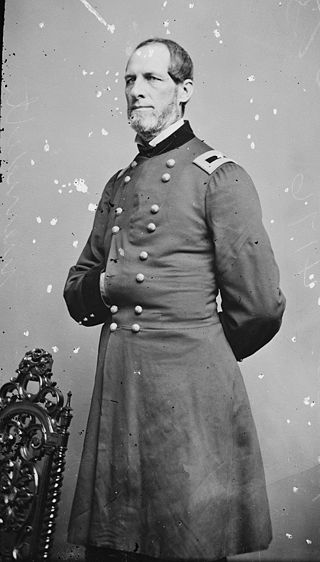
Solomon Meredith was a prominent Indiana farmer, politician, and lawman who became a controversial Union Army general in the American Civil War. One of the commanders of the Iron Brigade of the Army of the Potomac, Meredith led the brigade in the Battle of Gettysburg. Although he never fully recovered from the wounds he received that day, he became a prize-winning farmer and cattleman at home and hosted veterans of his unit.
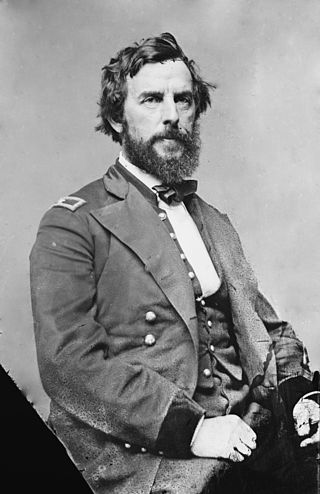
Rufus King was an American newspaper editor, public servant, diplomat, and soldier. He served as a Union Army brigadier general in the American Civil War, and was responsible for assembling the famed Iron Brigade of the Army of the Potomac. He was later U.S. minister (ambassador) to the Papal States from 1864 to 1867 and was instrumental in the capture of accused Lincoln assassination plotter John Surratt. Earlier in life, he had been a member of the first board of regents of the University of Wisconsin.

Brigadier-General Clement Anselm Evans was a senior officer of the Confederate States Army who commanded infantry in the Eastern Theater of the American Civil War. Afterwards, he edited a 12-volume work on Confederate military history, so named, in 1899.

Major-General Joseph Robert Davis was an American politician and lawyer who served as the commanding general of the Mississippi National Guard from 1888 to 1895. During the American Civil War, he served as aide-de-camp to the President of the Confederate States and commanded a brigade in the Army of Northern Virginia. He is best known for his role at Gettysburg. A member of the Democratic Party, he represented Madison and Scott counties in the Mississippi Senate from 1860 to 1861.
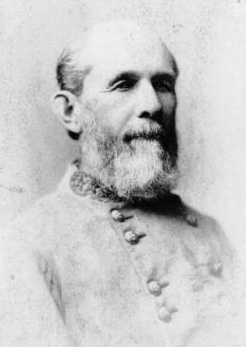
William Tatum Wofford was an officer during the Mexican–American War and a general in the Confederate States Army during the American Civil War.

The Battle of Fort Recovery, 30 June – 1 July 1794, was a battle of the Northwest Indian War, fought at the present-day village of Fort Recovery, Ohio. A large force of warriors in the Western Confederacy attacked a fort held by United States soldiers deep in Ohio Country. The United States suffered heavy losses, but maintained control of the fort. The battle exposed a division in the Western Confederacy's military strategy at a time when they seemed to hold the advantage, and the United States pressed farther into the Northwest Territory.
Orland Smith was a railroad executive and a brigade commander in the Union Army during the American Civil War. In 1863, he led a spirited bayonet charge during the Battle of Wauhatchie that took a significant Confederate position on a hill that now bears his name.

The 19th Regiment Indiana Volunteer Infantry was an infantry regiment that served in the Union Army during the American Civil War. It was one of the original regiments in the Army of the Potomac's Iron Brigade.

The Iron Brigade, also known as The Black Hats, Black Hat Brigade, Iron Brigade of the West, and originally King's Wisconsin Brigade was an infantry brigade in the Union Army of the Potomac during the American Civil War. Although it fought entirely in the Eastern Theater, it was composed of regiments from three Western states that are now within the region of the Midwest. Noted for its strong discipline, its unique uniform appearance and its tenacious fighting ability, the Iron Brigade suffered the highest percentage of casualties of any brigade in the war.

Franklin Aretas Haskell was a Union Army officer during the American Civil War and was killed at the Battle of Cold Harbor. Haskell wrote a famous account of the Battle of Gettysburg that was published posthumously.
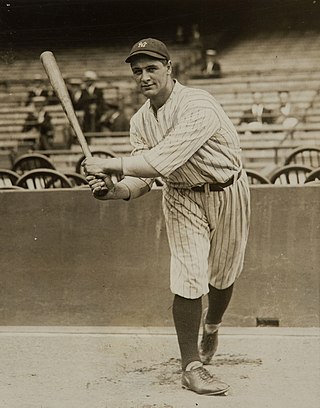
Henry Louis Gehrig was an American professional baseball first baseman who played 17 seasons in Major League Baseball (MLB) for the New York Yankees (1923–1939). Gehrig was renowned for his prowess as a hitter and for his durability, which earned him his nickname "the Iron Horse". He is widely regarded as one of the greatest baseball players of all time. He was an All-Star seven consecutive times, a Triple Crown winner once, an American League (AL) Most Valuable Player twice, and a member of six World Series champion teams. He had a career .340 batting average, .632 slugging average, and a .447 on base average. He hit 493 home runs and had 1,995 runs batted in (RBI). He still has the highest ratio of runs scored plus runs batted in per 100 plate appearances (35.08) and per 100 games (156.7) among Hall of Fame players. In 1939, he was elected to the Baseball Hall of Fame and was the first MLB player to have his uniform number (4) retired by a team.

LaBalme's Defeat was a military engagement which occurred on November 6, 1780, between a force of Canadien settlers under the command of French officer Augustin de La Balme and British-allied Miami warriors led by chief Little Turtle during the American Revolutionary War. La Balme had led the hastily recruited force of irregulars to attack British-held Fort Detroit, but was ambushed by a group of Miami warriors after sacking their town of Kekionga on the way. The victory led Little Turtle to become well known on the American frontier, a reputation which would develop during the Northwest Indian War.

George Boardman Boomer was a Union Army colonel who served as a brigade commander between February 12, 1863, and May 22, 1863, during the American Civil War. His principal service was during the heavy engagement of his brigade on May 16, 1863, at the Battle of Champion Hill during the Vicksburg campaign and in the second assault on Vicksburg on May 22, 1863. Colonel Boomer was killed near the Railroad Redoubt on the second day of major assaults on the City of Vicksburg on May 22, 1863.

William Smith Hanger Baylor was an American lawyer and soldier who served as a colonel in the Confederate States Army during the American Civil War.
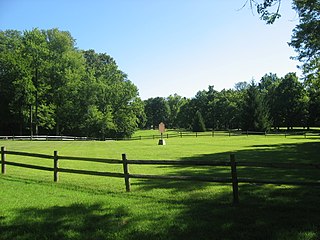
Fort St. Clair was a fort built during the Northwest Indian War near the modern town of Eaton, Preble County, Ohio. The site of the fort was listed on the National Register of Historic Places in 1970.
Asa Hartshorne was a United States Army officer who died in 1794 during the Northwest Indian War. He was among the signers of the Treaty with the Six Nations and the Treaty with the Wyandot at Fort Harmar on January 9, 1789. Hartshorne became the namesake of a 1790 frontier skirmish near Maysville, Kentucky.
References
- ↑ Boylen, Patrick (4 July 2013). "Alan Gaff". Whatzup. Archived from the original on 2 February 2023. Retrieved 22 September 2023.
- ↑ Bradford, James C. (3 November 2009). A Companion to American Military History. John Wiley & Sons. p. 61. ISBN 978-1-4443-1511-0.
- ↑ Herdegen, Lance J. (21 September 2005). The Men Stood Like Iron: How the Iron Brigade Won Its Name. Indiana University Press. p. 231. ISBN 978-0-253-21825-4.
- ↑ Skaggs, David Curtis; Nelson, Larry L. (1 January 2012). Sixty Years' War for the Great Lakes, 1754-1814. MSU Press. p. XX. ISBN 978-1-60917-218-3.
- ↑ "Alan D. Gaff". Simon & Schuster. Retrieved 22 September 2023.